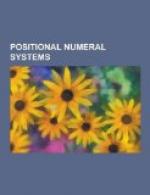|
This section contains 990 words (approx. 4 pages at 300 words per page) |

|
The binary number system, also called the base-2 number system, is a method of representing numbers that counts by using combinations of only two numerals: zero (0) and one (1). Computers use the binary number system to manipulate and store all of their data including numbers, words, videos, graphics, and music.
The term bit, the smallest unit of digital technology, stands for "BInary digiT." A byte is a group of eight bits. A kilobyte is 1,024 bytes or 8,192 bits.
Using binary numbers, 1 + 1 = 10 because "2" does not exist in this system. A different number system, the commonly used decimal or base-10 number system, counts by using 10 digits (0,1,2,3,4,5,6,7,8,9) so 1 + 1 = 2 and 7 + 7 = 14. Another number system used by computer programmers is the hexadecimal system, base-16, which uses 16 symbols (0,1,2,3,4,5,6,7,8,9,A,B,C,D,E,F), so 1 + 1 = 2 and 7 + 7 = E. Base-10 and base-16 number systems are more compact than the binary system. Programmers use the hexadecimal...
|
This section contains 990 words (approx. 4 pages at 300 words per page) |

|



